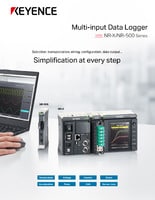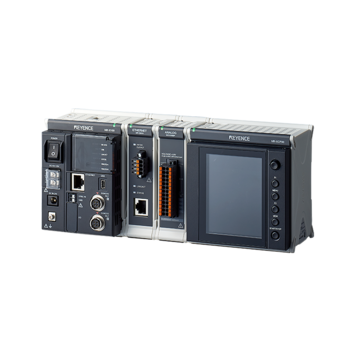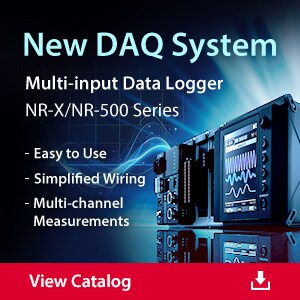Data Acquisition (DAQ)
Current Measurement Applications
This page provides an easy-to-understand explanation of how to measure “4 to 20 mA analog current output,”, its importance, and the methods and devices used to carry out the measurements. How to make measurement results easier to understand is also introduced here.
Industrial measurement implies measuring various properties, such as height, length, temperature, pressure, torque, etc. Data acquisition systems, however, don’t have built-in thermometers, tape measures, or pressure gauges to read and record all those properties. Instead, they usually rely on digital and analog signal conversion to acquire the readout.
The 4 to 20 mA analog current output is the standard analog signal in industrial automation and control systems primarily used for transmitting sensor data. In other words, the transducers measure a particular physical property, which is then converted into an analog current measurement that’s subsequently recorded by the data acquisition system.
Importance and Relevance of Measuring 4 to 20 mA Analog Current Output
The importance of 4 to 20 mA current output measurement in industrial control systems can’t be understated due to its robustness, simplicity, reliability, noise resistance, and the ability to transfer signal information over long distances—up to 500 meters or 1,640 feet.
The 4 to 20 mA analog signaling is standard because it allows for easy detection of any line faults or breaks due to its live zero value, with 4 mA representing the lowest end of the measurement scale. In other words, if the current measurement falls below the aforementioned 4 mA live value, there’s a fault in the current measurement circuit.
Additionally, this type of analog signaling is compatible with various industrial equipment, making it a universal choice for process control, as it helps maintain the accuracy and efficiency of the industrial process.
We’re here to provide you with more details.
Reach out today!

How to Measure Current
Current measurements in the 4 to 20 mA range require current measuring devices that are calibrated to measure current values within this range. Measuring current means the device is calculating the flow of electrical current. The measuring device has to be connected in series with the current to measure its flow.
Curious about our pricing?
Click here to find out more.

Current Measurement Methods
As explained above, measuring current would imply wiring the current measurement device (typically a multimeter) in series with the flow of electrical current. However, this is highly intrusive, and it disrupts the circuit operation.
Discover more about this product.
Click here to book your demo.

Current Measuring Devices
In the context of measuring 4 to 20 mA current signals, it’s best to use a digital multimeter, which would imply having to wire the multimeter in series with the current flow or use a data acquisition system processing unit such as NR-HA08/08P high-speed analog measurement unit.
Another method for current measurement is to wire a precision shunt resistor inside the circuit and convert the current signal into a voltage drop, which is much more easily measured and processed by the processing unit before relaying the voltage signal to the data acquisition system.
We’re here to provide you with more details.
Reach out today!

Types of Current Sensors
Sensors with 4 to 20mA current signal output are used for monitoring physical properties and related manufacturing processes. This includes the following sensors:
- KEYENCE FT Series — Series of IR temperature measurement sensors
- KEYENCE FD-EP Series — Sensors for measuring airflow and pressure
- KEYENCE FD-R Series — Sensors for measuring the flow of liquids
- KEYENCE FL Series — Liquid level sensor
This is only an example of sensors relying on the 4-20mA current output. Given the ubiquity of the 4 to 20 mA signal current in industrial current applications, it’s safe to assume many other sensors use this output as well.
Discover more about this product.
Click here to book your demo.

Data Acquisition Device Measurements
Data acquisition devices, such as KEYENCE’s NR-X Series, are used in pairs with the processing units to process, condition, record, and retrieve the recorded signal data. NR-X Series is the most compact portable DAQ in its class. Its modular constructions allow you to attach up to eight different processing units with up to 576 channels. Among many signal inputs it’s capable of processing, the NR-X Series pairs with NR-HA08/08P to process and record 4 to 20 mA signals across four input channels per module. Several modules can be used.
KEYENCE provides comprehensive industrial measurement solutions for a variety of different industrial current applications. If you’re interested in integrating 4 to 20 mA current output sensors and a data acquisition system, give us a call, and we’ll answer all and any inquiries you might have regarding integration.
Get detailed information on our products by downloading our catalog.
View Catalog



